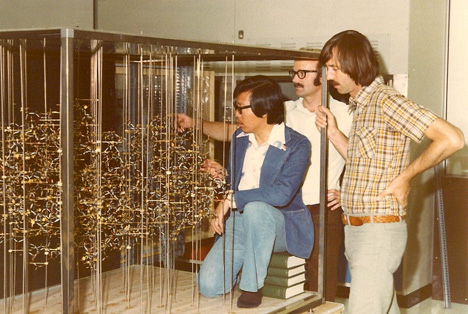Obituary - Michael JamesBiography | Publications | Curriculum Vitae | Videos | Slides | Articles | Obituary
Remembering Michael James
An official scientific obituary for Michael James has been published in Acta Cryst D. For RefleXions, we have given Michael’s colleagues the opportunity to submit material that expresses their gratitude and joy in having known this well-loved and highly-respected scientist. Natalie Strynadka
Re: Order of Canada nomination for Professor Michael N.G. James I am writing to provide strong support for the nomination of Professor Michael N.G. James to the Order of Canada. As a structural biologist who undertook PhD training with Dr. James and now am UBC Dis- tinguished Professor of Biochemistry and CRC Tier I chair in Structure-guided Antibiotic Discovery, I am very familiar with the ground breaking contributions Professor James has made throughout his career to the field of macromolecular xray crystallographic analysis of proteins important to human health. In short, I consider him the singular leading member of a historically impressive Canadian macromolecu- lar structural biology community cohort, whose pioneering work paved the way for several generations of investigators, many trained in his laboratory directly or subsequently by trainees from his laborato- ry. From his founding DPhil with Nobel laureate Dorothy Hodgkin at Oxford University through to his independent establishment of the first macromolecular structural biology laboratory in Canada at the University of Alberta and remarkable ongoing success in the near 5 decades since, Professor James has achieved milestone after milestone of highest impact, world-leading research achievements in the development and application of xray crystallography to the understanding of macromolecular structure/ function. In terms of application, Professor James research has always worked at the cutting edge of xray crystallography development, with many first to field applications including the methods development and use of protein refinement, essentially complex algorithms that take into account the experimental data and structural models to optimize their precision and analysis and ultimate understanding of the under- lying function their atomic positions imply. In the early days, development of this refinement software (we now so take for granted) required new to field computing technology (the first main frame com- puters with anything approaching suitable power to compile and run these newly emerging programs) with program changes done on series of punch cards requiring thousands of trips back and forth to the main computing hub on campus for recompile and running. His laboratory was also the first to use and help optimize new to the field graphics computers to illustrate the electron density maps (the data) for subsequent model building, completely revolutionary at the time, which allowed him to apply and train students and postdoctoral fellows in these methods and applications many years before they became mainstream. His impressive list of milestone, high(est) impact papers that resulted from this state of the art xray crystallographic methods development with ongoing multiple corresponding manuscripts in Nature, Science and other top journals directly speak to his research accomplishments. His fundamen- tal ongoing contributions to atomic resolution and mechanistic understanding of both prokaryotic and eukaryotic proteases and their inhibitors spans his career, informing therapeutic development based on these enzymes throughout. In parallel with his outstanding research achievements, Professor James has been a tireless advocate for fostering xray crystallography training in his laboratory and at all levels in Canada and internationally. His own love and energy for the atomic details of the science he taught and worked at combined with an incredible work ethic were an inspiration and one that profoundly has shaped my own career here at UBC. In combination with the success he has brought to additional outreach roles at the institute, national and international level defines, in short, a truly outstanding Canadian scientist. I cannot think of another person in our field more worthy of national recognition by the Order of Canada than Professor James. Sincerely,
Natalie C.J. Strynadka, PhD, FRSC, FRS UBC Distinguished Professor of Biochemistry
CRC Tier I in Antibiotic Discovery
Randy ReadI hear that you’re collecting pictures of Michael James for ACA Reflexions. I’ve found a couple from my days as a PhD student with him, which show his fun-loving side!
The first one is from a hiking trip in the Rockies, the second from a Halloween party where he came as a fictional hockey player called Big Bobby Clobber.
David RoseI am attaching my nomination letter for Michael James’ Fellowship in 2016. Feel free to excerpt, edit, plagiarize as you need. American Crystallographic Association Dear Colleagues: By this letter, I am enthusiastically nominating Michael James to be an ACA Fellow. In my opinion (and by my own admission of negligence), Michael should have been named an ACA Fellow long before now, and I am still embarrassed that I beat him to it. It is no exaggeration to say that Michael is the founding father of macromolecular crystallography in Canada, and one of the first in North America. Following his DPhil with Dorothy Hodgkin in Oxford in 1966, Michael began his long career at Alberta, beginning in 1967 as a postdoctoral fellow. Michael’s transition to proteins started immediately on his appointment to the faculty, with his first protein publication appearing in 1974, not long after the lysozyme structure. Within a couple of years, he had transitioned almost fully to proteins, with his seminal work on serine proteases. His publication record of over 320 peer-reviewed papers (h-index at least 65: hard to know for sure, as many papers were before the development of the indexing process) include several that laid the foundation for the understanding of acid protease mechanisms and, by extension, all proteases. He has obviously gone on to investigate many other proteins systems as well, and is still publishing papers. Michael’s list of trainees is a Who’s Who of Canadian macromolecular crystallographers over several generations. His scientific children and grandchildren run major laboratories nationally and interna- tionally. The list includes such people as Delbaere (former ACA President), Read, Brayer, Strynadka, Fraser, Mosimann, Ng, Allaire and many others. In terms of the ACA, Michael has been a member for over 30 years, having been Chair of the Macro- molecular SIG in 1985-86, and Canadian Representative on Council for the past 3 years. In 2009, he received the Buerger Award from the ACA for his lifetime of contributions to the establishment of protein crystallography in North America. He has received many other awards and recognitions, including honorary degrees and Fellowships in the Royal Societies of both Canada and the UK. In recognition of these and other accomplishments, for his seminal role in the establishment of protein crystallography in North America and the ACA, his extensive research contributions, and his remarkable record of high-quality training, I am pleased to nominate Michael James for Fellow of the ACA. His enthusiasm and wisdom will be extremely valuable to the organization as we approach a critical time of transition. David R. Rose Louise DaweMichael served as a valued mentor to me since 2013. He has always made time to meet with me individually, to attend meals, and even to spend time as my travel companion back to Canada from the 2015 ACA meeting. I have trusted him with many concerns and issues that I have encountered as a pre-tenure faculty member, and his advice to me and his patience in listening to my thoughts has provided me with insights into topics ranging from supervising my own students, to applying for grants, and interacting with colleagues. With his large community of friends and colleagues in the ACA, there was no professional advantage for him to have spent time helping me; I know that he did this because he was sincerely committed to facilitating the success of young scientists, and I appreciate this more than he ever knew. Emil PaiThe first time I visited North America, attending the 11th IUBMB Congress in Toronto in 1979, was also the first time I met Michael. He showed his results on protease structures. Michael’s clear presentation impressed me immensely and, as a chemist, I was especially taken by how he interpreted the structures in terms of reaction mechanisms. After his talk, I approached to thank him for the mercury compound his laboratory had sent to Heidelberg to help me determine my first protein crystal structure. I also took the opportunity to ask him a quick question, probably about penicillopepsin. A dozen years later, I moved to the University of Toronto and was assigned the very lab in which Mi- chael’s collaborator Theo Hofmann had purified and sequenced just this enzyme and obtained the first crystals. Theo stayed on as an Emeritus for many years and as a present to his 93rd birthday we re-de- termined the penicillopepsin crystal structure from crystals that had survived from the original almost 40 year old batch. When Theo told Michael about this, Michael was elated and said he would ask for a similar present for one of his next birthdays, too. Michael was kind, humorous, always ready to discuss enzyme mechanisms and prepared to defend his proposals with many well thought out arguments. He was elected or asked to serve on many commit- tees and used these positions to support his colleagues and advance the science of macromolecular crystallography. We have lost an eminent scientist and a great friend and colleague.
Marie Elizabeth FraserMy first personal encounter with Michael James was at the American Crystallographic Association meeting in Hamilton in 19ti6. I had written to Michael about a postdoctoral position in his lab, and since we were both attending the Hamilton meeting, we arranged to meet in person. Michael was standing in a semi-circle with people who were currently or previously working in his lab. A previous graduate student said that they had enjoyed working in the lab so much they had stayed six years for their Ph.D. That seemed an excellent advertisement of the lab as a good place to learn protein crystallography.
Michael enjoyed working with his graduate students and postdoctoral fellows. He would often solve the structure of a small molecule with a new graduate student, giving them a faster introduction to crystallography than they would gain crystallizing and solving the structure of their first protein. In the wet lab, Michael examined new crystals, discussing their symmetry and the possible space groups to teach crystallographic symmetry. In the graphics lab, he joined each trainee to look at electron density maps and would comment on the fit of the amino acid residues or inhibitors to the density. One graduate student joked that Michael would poke his head into the room and comment that a leucine side chain was in the wrong conformation. Most of all, we learned from Michael about the excitement of discovery, seeing molecular interactions for the first time and interpreting from the structures how the proteins functioned. Journal club on Wednesdays was another opportunity for teaching and learning. In those days before PubMed, two research labs joined together for journal club, and each participant was assigned a journal and would report on papers of interest to the labs. We learned about current research but also had the opportunity to hear critical discussion from Michael, the other principal investigator, and fellow lab members. Both at those journal clubs and when Michael was previewing any of our presentations, we learned to be critical of our own work as well as the work of others. Michael enjoyed working the lab. At the time, working evenings and weekends was common, and Michael would could be found in the lab on a Saturday. When I first arrived in Edmonton, I remember stopping by the lab on Saturday to let Michael know I was in Edmonton. Saturday was a quiet day on campus since there were no classes, so it was a good time for Michael to focus on research. When I searched through photographs from that time in my life, I found many of hiking and skiing with people from the lab, but none of those photographs included Michael. The few pictures with Michael were taken at work events. Michael was a proud founding member of the Canadian Medical Research Council Group in Protein Structure and Function. On one occasion, the seven labs that formed the Group held a retreat, and two pictures were from that retreat, one showing all labs and the other showing just Michael’s lab (Figure). Michael was not averse to taking part in activities outside the lab, but I mostly observed that on trips to conferences. Prior to a Gordon Research Conference, we visited my family’s cottage north of Ottawa where Michael and I canoed. After a quick entry into the water, fortunately right by the shore, we got the hang of working together. Michael was interested in many things, and I recall him pointing to the horsetails growing near the cottage and commenting on how ancient the plant was.
I have many other memories of Michael James, but the excitement of discovery, the joy of doing research with other scientists, and the importance of being critical of our work are what I best remember learning from him. Bernie SantarsieroI was trained as a small molecule crystallographer but had been exposed to the determination of protein structures throughout my graduate studies through weekly seminars with the structural group at the University of Washington. From 19ti0 to 19ti6, I was a postdoc at Caltech, doing small molecule crystallography. I decided to switch to protein studies and was lucky to find a position with Mike from 19ti6 to 1991 as a postdoctoral research fellow, and initially worked on the structure of rat parvalbumin with data from a diffractometer and our new ADSC Mark II Xuong-Hamlin area detector.
(1977, Photo courtesy of Graheme Williams and Gary Brayer) Early on, the lab was recognized for some key studies, from the structures of penicillopepsin, troponin C, beta-lactamase and renin, to develop new drugs. He gave everyone opportunities to learn and grow, and many of the researchers in his lab have gone on to lead protein crystallography into a new era. He was always patient, helpful, energetic, and supportive. Not only did I learn how to purify a protein (before cloning and protein expression was routine) but I learned about molecular replacement, heavy atom phasing, data collection from area detectors, crystallization, and refinement. To learn more about synchrotron sources, I was sent to Chicago to attend the first BioSync meeting in 1990 which supported funding a new synchrotron at Argonne National Lab. I learned so much from my time as a postdoc in the lab. It was a small, cohesive, active, productive, and friendly research group. We often attended the Jazz or the Fringe Theatre (plays) Festivals, and went out to dinner together. I will miss that infectious smile. |

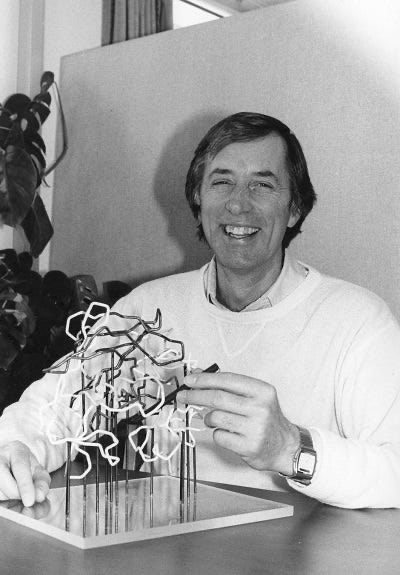
 A letter I provided for his Order of Canada nomination (awarded this year) is included below. Unfortunately many of my photos (real not digital) were lost amongst others in a flood several years ago. But the one at- tached, is one I find very reflective of his absolute, in- fectious love for protein structure and crystallography. Not just posing, this photo of him is truly reflective of the many hours daily he would pore over maps, struc- tures, figures. He loved the details of these structures, and taught us all to appreciate the value in determining and analyzing them with utmost care and appreciation for the myriad of information they encode. Michael’s lab also provided an amazing training atmosphere of both people (pioneers of crystallography and enzymology that regularly passed through the halls) and state of the art infrastructure (for example you can see the enormous MMSX data disks stacked behind him in this photo, the first graphics computers in Canada). I also recall many amazing lab dinners, concerts and hiking trips that were also a constant thread of the lab social fabric. I will always be grateful for the time in his laboratory and how it shaped my scientific view of the world.
A letter I provided for his Order of Canada nomination (awarded this year) is included below. Unfortunately many of my photos (real not digital) were lost amongst others in a flood several years ago. But the one at- tached, is one I find very reflective of his absolute, in- fectious love for protein structure and crystallography. Not just posing, this photo of him is truly reflective of the many hours daily he would pore over maps, struc- tures, figures. He loved the details of these structures, and taught us all to appreciate the value in determining and analyzing them with utmost care and appreciation for the myriad of information they encode. Michael’s lab also provided an amazing training atmosphere of both people (pioneers of crystallography and enzymology that regularly passed through the halls) and state of the art infrastructure (for example you can see the enormous MMSX data disks stacked behind him in this photo, the first graphics computers in Canada). I also recall many amazing lab dinners, concerts and hiking trips that were also a constant thread of the lab social fabric. I will always be grateful for the time in his laboratory and how it shaped my scientific view of the world.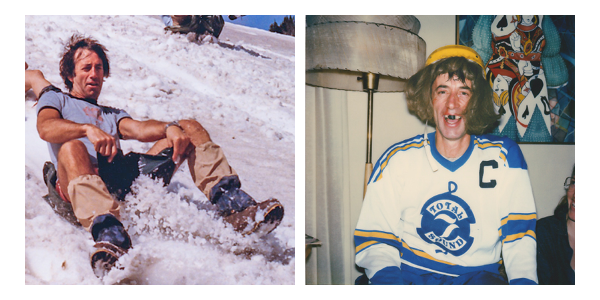
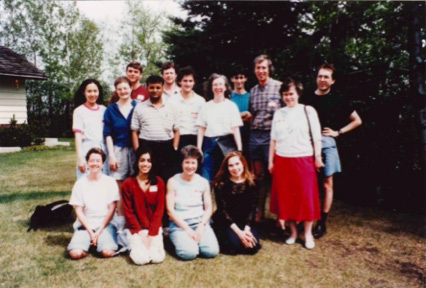
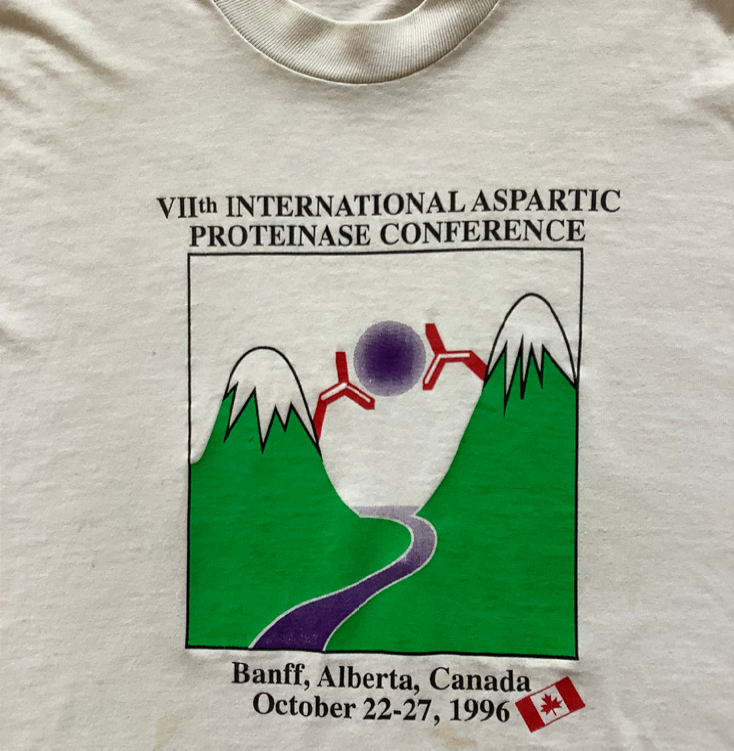 Michael enjoyed the camaraderie of the scientific community. The major conference he organized while I was in his lab was the 7th International Conference on Aspartic Proteinases in Banff, Alberta. A memento of that meeting is the T-shirt he designed with mountains representing the two lobes of the aspartic proteinases (Figure 2). In addition to the science, a highlight of the conference was square dancing led by a caller from Calgary. When so many scientists and their families participated in the event, Michael wanted to be sure to thank the caller for their contribution to the event. Like many other scientists, Michael enjoyed the opportunities conferences provided to interact with peers both professionally and socially.
Michael enjoyed the camaraderie of the scientific community. The major conference he organized while I was in his lab was the 7th International Conference on Aspartic Proteinases in Banff, Alberta. A memento of that meeting is the T-shirt he designed with mountains representing the two lobes of the aspartic proteinases (Figure 2). In addition to the science, a highlight of the conference was square dancing led by a caller from Calgary. When so many scientists and their families participated in the event, Michael wanted to be sure to thank the caller for their contribution to the event. Like many other scientists, Michael enjoyed the opportunities conferences provided to interact with peers both professionally and socially.